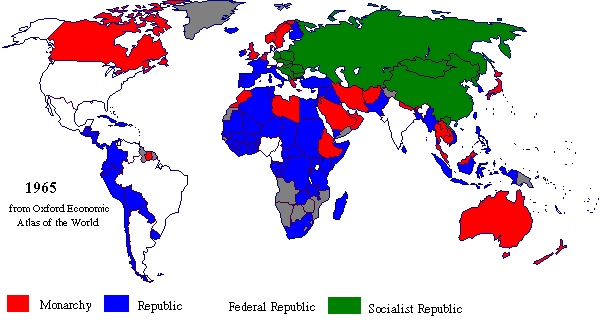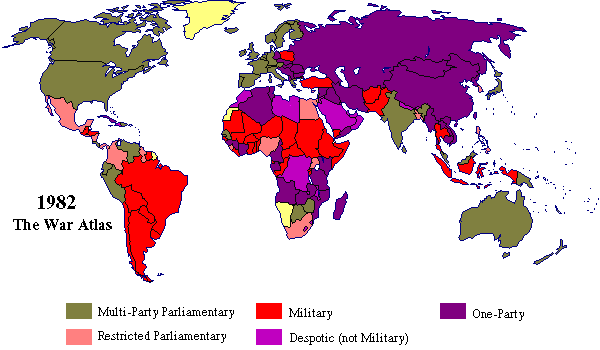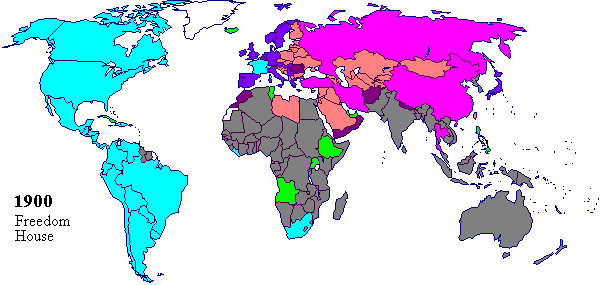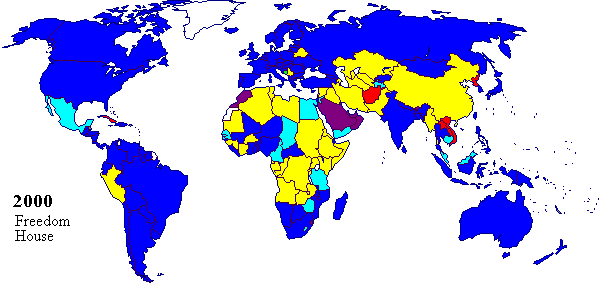

This is a rather straight-forward classification by constitutional structure which leaves very little open to interpretation or debate. If the head of state is a monarch, then it's a monarchy, period. If the central government shares power with the constituent parts, then it's a federal republic. Very neat and clean.
Notice, however, that it doesn't concern itself with such things as civil rights. England, France and the United States are scattered into different categories despite the fact that they generally treat their citizens alike. The Netherlands and Sweden are lumped in with Saudi Arabia and Iran despite the enormous difference in how much power the monarch wields.
Also, the category of "republic" is something of a catch-all set aside for all the countries which aren't something else.

While comparing the level of violence in America with the level elsewhere, Ted Robert Gurr charted violence in most of the world's nations according to several indicators such as political system -- which I've transformed into the map here. He said the classification system was devised by Arthur S. Banks and Phillip M. Gregg.
Generally, this system is based on the underlying power structure of society, rather than its nominal constitutional organization. Polyarchic, for example -- Greek for "many leaders" -- applies to nations with Western-style democracies. Elitist refers to recently independent nation with small, modernizing elites. Personalist is characterized by unstable personalistic political leadership, while Centrist covers strict authoritarian regimes.
The main problem with this system is the Huh? Factor. It's difficult to figure it out at first glance. How is Peru more similar to Syria than it is Spain? What do Iran and the USSR share with each other that they don't with Jordan?
Also, in order to classify 100 years of governments, I would have to gather huge tables of social statistics from all over the globe, rather that just opening a history book and looking for key words like "coup", "elections", "independence", "abdicated" etc. (which is how I did the research for my maps)

If this map looks a little familiar, that's because this is the system that I started with. This system classifies governments according to where the actual decision-making occurs: a parliament, a party, a junta or just one guy. I liked this system right away.
(For my series of maps, I made a few modifications -- which of course seriously bastardized the original system. I split "despotic" into "absolute monarchy" and republican "autocracy". I split "Communist" off of "one-party".)

| Monarchies: | Constitutional Monarchy | Traditional Monarchy | Absolute Monarchy |
| Republics: | Democracy | Restricted Democratic Practice | Authoritarian Regime |
| Totalitarian Regime | |||
| Non-Sovereign: | Protectorate | Colonial Dependency | Empire |

| Monarchies: | Constitutional Monarchy | Traditional Monarchy | Absolute Monarchy |
| Republics: | Democracy | Restricted Democratic Practice | Authoritarian Regime |
| Totalitarian Regime | |||
| Non-Sovereign: | Protectorate | Colonial Dependency | Empire |

The human rights group, Freedom House tossed together this system for their turn-of-the-century wrap-up. Although the original data is only in a table, I've put extra effort into mapping this system because it's probably the most authoritative alternative to my maps, and worth serious consideration. It's an excellent depiction of the world in 2000.
On the minus side, I'm not sure that we really need three different categories of monarchy in order to understand the Twentieth Century, and they don't even seem to be consistent with it. (The UK and Norway are classed as constitutional monarchies in 1900, but democracies in 1950 and 2000) Also, except for a few special cases (post-war Germany and Japan, modern Bosnia), drawing a distinction between a protectorate and colony seems to be, at best, legalistic and pedantic, and, at worst, euphemistic. And I definitely disagree with putting most of the Western Hemisphere into the same category in 1900. (If nothing else, Canada was a constitutional monarchy, and Mexico was an out-and-out dictatorship.)
[Go Back to Government Home Page]
Last Updated January 2003
Copyright © 1999-2003 Matthew White